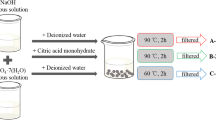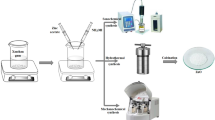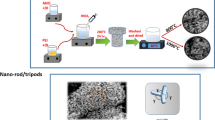Abstract
Structural modification of nanoparticles (NPs) for application-specific study is timely. In the present investigation, an attempt has been made for the bioinspired synthesis of zinc oxide (ZnO) NPs possessing different morphologies using glycine as the bio-capping agent. A variation in the amount of glycine during low-temperature mediated solid-phase synthesis indicated that a higher ratio of glycine directed the ensemble of nanohexagons into nanobundles which further formed nano-flower buds- like morphology, while least concentration formed agglomerated NPs and moderate concentration of glycine was able to modify the NPs’ structure into nanorods. On the other hand, the utilization of solution-phase synthesis methods, i.e. co-precipitation and hydrothermal, led to the formation of thinner and thicker ZnO nanosheets, respectively. In terms of crystalline structure, not much difference was observed in the lattice parameters or the unit cell of the crystal, with approximately similar crystallite sizes. From Fourier transform infrared spectroscopy, the functionalization of glycine from both the amine and the carboxyl group was noted. Further, it was found that the morphology and photoluminescence emission spectra of the samples were inter-related, wherein higher the agglomeration of the particles, greater the intensity of the visible region defect band was observed. The as-synthesized ZnO-photocatalysts were then employed for the degradation of rhodamine B (RhB), a major effluent of the textile industry. The photocatalytic activity of the samples was found to depend upon the surface area, which in turn was related to the morphology and the magnitude of green emission defect states. About 99% RhB degradation was obtained with ZnO possessing nano-flower buds-like morphology within 60 min of sunlight irradiation. Additionally, the role of reactive oxidative species and the stability of this photocatalyst were investigated.












Similar content being viewed by others
References
R. Tripathi, A. Kumar, C. Bharti, T.P. Sinha, Dielectric relaxation of ZnO nanostructure synthesized by soft chemical method. Curr. Appl. Phys. 10, 676–681 (2010). https://doi.org/10.1016/j.cap.2009.08.015
S.S. Ashtaputre, A. Deshpande, S. Marathe, M.E. Wankhede, J. Chimanpure, R. Pasricha, J. Urban, S.K. Haram, S.W. Gosavi, S.K. Kulkarni, Synthesis and analysis of ZnO and CdSe nanoparticles. Pramana J. Phys. 65, 615–620 (2005). https://doi.org/10.1007/bf03010449
L. Wu, Y. Zhang, G. Yang, S. Zhang, L. Yu, P. Zhang, Tribological properties of oleic acid-modified zinc oxide nanoparticles as the lubricant additive in poly-alpha olefin and diisooctyl sebacate base oils. RSC Adv. 6, 69836–69844 (2016). https://doi.org/10.1039/c6ra10042b
M.A. Morris, L. Chen, J.D. Holmes, S. Ramrez-Garca, Facile synthesis of monodisperse ZnO nanocrystals by direct liquid phase precipitation. J. Nanomater. (2011). https://doi.org/10.1155/2011/853832
P.D. Cozzoli, A. Kornowski, H. Weller, Colloidal synthesis of organic-capped ZnO nanocrystals via a sequential reduction–oxidation reaction. J. Phys. Chem. B. 109, 2638–2644 (2005). https://doi.org/10.1021/jp0457139
A.K. Singh, V. Viswanath, V.C. Janu, Synthesis, effect of capping agents, structural, optical and photoluminescence properties of ZnO nanoparticles. J. Lumin. 129, 874–878 (2009). https://doi.org/10.1016/j.jlumin.2009.03.027
P. Basnet, D. Samanta, T. Inakhunbi Chanu, J. Mukherjee, S. Chatterjee, Assessment of synthesis approaches for tuning the photocatalytic property of ZnO nanoparticles. SN Appl. Sci. 1, 633 (2019). https://doi.org/10.1007/s42452-019-0642-x
P. Basnet, T.I. Chanu, D. Samanta, S. Chatterjee, J. Mukherjee, Removal of cationic water pollutants using PEG stabilized ZnO nanoparticles under solar irradiation. in Proceedings of the Dae Solid State Physics Symposium 2018 (2019), p. 030204. https://doi.org/10.1063/1.5113043
X. Sun, X. Chen, Z. Deng, Y. Li, A CTAB-assisted hydrothermal orientation growth of ZnO nanorods. Mater. Chem. Phys. 78, 99–104 (2003). https://doi.org/10.1016/S0254-0584(02)00310-3
H. Zhang, D. Yang, Y. Ji, X. Ma, J. Xu, D. Que, Low temperature synthesis of flowerlike ZnO nanostructures by cetyltrimethylammonium bromide-assisted hydrothermal process. J. Phys. Chem. B. 108, 3955–3958 (2004). https://doi.org/10.1021/jp036826f
T.T. Trinh, K.-Q. Tran, X.-Q. Zhang, R.A. van Santen, E.J. Meijer, The role of a structure directing agent tetramethylammonium template in the initial steps of silicate oligomerization in aqueous solution. Phys. Chem. Chem. Phys. 17, 21810–21818 (2015). https://doi.org/10.1039/C5CP02068A
J.Q. Hu, Q. Li, N.B. Wong, C.S. Lee, S.T. Lee, Synthesis of uniform hexagonal prismatic ZnO whiskers. Chem. Mater. 14, 1216–1219 (2002). https://doi.org/10.1021/cm0107326
P. Basnet, D. Samanta, T.I. Chanu, J. Mukherjee, S. Chatterjee, Tea-phytochemicals functionalized Ag modified ZnO nanocomposites for visible light driven photocatalytic removal of organic water pollutants. Mater. Res. Express. 6, 085095 (2019). https://doi.org/10.1088/2053-1591/ab234e
J. Zhou, N.S. Xu, Z.L. Wang, Dissolving behavior and stability of ZnO wires in biofluids: a study on biodegradability and biocompatibility of ZnO nanostructures. Adv. Mater. 18, 2432–2435 (2006). https://doi.org/10.1002/adma.200600200
Q. Wu, X. Chen, P. Zhang, Y. Han, X. Chen, Y. Yan, S. Li, Amino acid-assisted synthesis of ZnO hierarchical architectures and their novel photocatalytic activities. Cryst. Growth Des. 8, 3010–3018 (2008). https://doi.org/10.1021/cg800126r
P. Basnet, T. Inakhunbi Chanu, D. Samanta, S. Chatterjee, A review on bio-synthesized zinc oxide nanoparticles using plant extracts as reductants and stabilizing agents. J. Photochem. Photobiol. B Biol. 183, 201–221 (2018). https://doi.org/10.1016/j.jphotobiol.2018.04.036
H. Mirzaei, M. Darroudi, Zinc oxide nanoparticles: biological synthesis and biomedical applications. Ceram. Int. 43, 907–914 (2017). https://doi.org/10.1016/j.ceramint.2016.10.051
J. Jiang, J. Pi, J. Cai, The advancing of zinc oxide nanoparticles for biomedical applications. Bioinorg. Chem. Appl. (2018). https://doi.org/10.1155/2018/1062562
V.G. Sreevalsa, P.P. Jeeju, M.S. Augustine, K.M. Anilkumar, S. Jayalekshmi, l-Histidine-modified biocompatible zinc oxide nanocrystals. J. Exp. Nanosci. 8, 937–946 (2013). https://doi.org/10.1080/17458080.2011.624553
M. Ramani, S. Ponnusamy, C. Muthamizhchelvan, E. Marsili, Amino acid-mediated synthesis of zinc oxide nanostructures and evaluation of their facet-dependent antimicrobial activity. Colloids Surf. B Biointerfaces 117, 233–239 (2014). https://doi.org/10.1016/j.colsurfb.2014.02.017
B. Liu, H.C. Zeng, Room temperature solution synthesis of monodispersed single-crystalline ZnO nanorods and derived hierarchical nanostructures. Langmuir. 20, 4196–4204 (2004). https://doi.org/10.1021/la035264o
C. Lao, Y. Li, C.P. Wong, Z.L. Wang, Enhancing the electrical and optoelectronic performance of nanobelt devices by molecular surface functionalization. Nano Lett. 7, 1323–1328 (2007). https://doi.org/10.1021/nl070359m
M. Stiboller, G. Raber, K.A. Francesconi, Simultaneous determination of glycine betaine and arsenobetaine in biological samples by HPLC/ICPMS/ESMS and the application to some marine and freshwater fish samples. Microchem. J. 122, 172–175 (2015). doi:https://doi.org/10.1016/j.microc.2015.04.022
R.Y. Gundersen, P. Vaagenes, T. Breivik, F. Fonnum, P.K. Opstad, Glycine—an important neurotransmitter and cytoprotective agent. Acta Anaesthesiol. Scand. 49, 1108–1116 (2005). https://doi.org/10.1111/j.1399-6576.2005.00786.x
E.A. Meulenkamp, Synthesis and growth of ZnO nanoparticles. J. Phys. Chem. B. 102, 5566–5572 (1998). https://doi.org/10.1021/jp980730h
E. Darvishi, D. Kahrizi, E. Arkan, Comparison of different properties of zinc oxide nanoparticles synthesized by the green (using Juglans regia L. leaf extract) and chemical methods. J. Mol. Liq. 286, 110831 (2019). https://doi.org/10.1016/j.molliq.2019.04.108
M.M. Mekonnen, A.Y. Hoekstra, Four billion people facing severe water scarcity. Sci. Adv. 2, e1500323 (2016). https://doi.org/10.1126/sciadv.1500323
M.A. Hanjra, M.E. Qureshi, Global water crisis and future food security in an era of climate change. Food Policy 35, 365–377 (2010). doi:https://doi.org/10.1016/j.foodpol.2010.05.006
S. Sharma, A. Bhattacharya, Drinking water contamination and treatment techniques. Appl. Water Sci. 7, 1043–1067 (2017). doi:https://doi.org/10.1007/s13201-016-0455-7
A. Ajmal, I. Majeed, R.N. Malik, H. Idriss, M.A. Nadeem, Principles and mechanisms of photocatalytic dye degradation on TiO2 based photocatalysts: a comparative overview. RSC Adv. 4, 37003–37026 (2014). https://doi.org/10.1039/C4RA06658H
E.A. Clarke, R. Anliker, Organic dyes and pigments. Handb. Environ. Chem. (1980). https://doi.org/10.1007/978-3-540-38522-6-7
D.A. Yaseen, M. Scholz, Textile dye wastewater characteristics and constituents of synthetic effluents: a critical review (Springer, Berlin, Heidelberg, 2019). https://doi.org/10.1007/s13762-018-2130-z
P.J. Price, W.A. Suk, A.E. Freeman, W.T. Lane, R.L. Peters, M.L. Vernon, R.J. Huebner, In vitro and in vivo indications of the carcinogenicity and toxicity of food dyes. Int. J. Cancer 21, 361–367 (1978). https://doi.org/10.1002/ijc.2910210318
E.Y. Ozmen, S. Erdemir, M. Yilmaz, M. Bahadir, Removal of carcinogenic direct azo dyes from aqueous solutions using calix[n]arene derivatives. Clean Soil Air Water 35, 612–616 (2007). https://doi.org/10.1002/clen.200700033
P. Ribao, J. Corredor, M.J. Rivero, I. Ortiz, Role of reactive oxygen species on the activity of noble metal-doped TiO2 photocatalysts. J. Hazard. Mater. (2019). https://doi.org/10.1016/j.jhazmat.2018.05.026
Y. Nosaka, A.Y. Nosaka, Generation and detection of reactive oxygen species in photocatalysis. Chem. Rev. 117, 11302–11336 (2017). https://doi.org/10.1021/acs.chemrev.7b00161
M. Maruthupandy, M. Anand, G. Maduraiveeran, S. Suresh, A.S. Hameedha Beevi, R. Jeeva, Priya, Investigation on the electrical conductivity of ZnO nanoparticles-decorated bacterial nanowires. Adv. Nat. Sci. Nanosci. Nanotechnol. (2016). https://doi.org/10.1088/2043-6262/7/4/045011
S. Campisi, M. Schiavoni, C. Chan-Thaw, A. Villa, Untangling the role of the capping agent in nanocatalysis: recent advances and perspectives. Catalysts. 6, 185 (2016). https://doi.org/10.3390/catal6120185
M. Vosoughifar, Influence of capping agents additives on morphology of cadmium tungstate nanoparticles and study of their photocatalytic properties. J. Mater. Sci. Mater. Electron. 28, 6800–6805 (2017). https://doi.org/10.1007/s10854-017-6377-9
E. Emil, G. Alkan, S. Gurmen, R. Rudolf, D. Jenko, B. Friedrich, Tuning the morphology of ZnO nanostructures with the ultrasonic spray pyrolysis process. Metals (Basel) (2018). https://doi.org/10.3390/met8080569
C. Dhand, N. Dwivedi, X.J. Loh, A.N. Jie Ying, N.K. Verma, R.W. Beuerman, R. Lakshminarayanan, S. Ramakrishna, Methods and strategies for the synthesis of diverse nanoparticles and their applications: a comprehensive overview. RSC Adv. 5, 105003–105037 (2015). https://doi.org/10.1039/c5ra19388e
D.H. Li, S.F. He, J. Chen, C.Y. Jiang, C. Yang, Solid-state chemical reaction synthesis and characterization of lanthanum tartrate nanocrystallites under ultrasonication spectra. IOP Conf. Ser. Mater. Sci. Eng. (2017). https://doi.org/10.1088/1757-899X/242/1/012023
Y. Li, Y. Cao, D. Jia, A general strategy for synthesis of metal nanoparticles by a solid-state redox route under ambient conditions. J. Mater. Chem. A. 2, 3761–3765 (2014). https://doi.org/10.1039/c3ta14427e
H. Yang, J. Yang, Photocatalytic degradation of rhodamine B catalyzed by TiO2 films on a capillary column. RSC Adv. 8, 11921–11929 (2018). https://doi.org/10.1039/c8ra00471d
U. Holzwarth, N. Gibson, The Scherrer equation versus the “Debye–Scherrer equation. Nat. Nanotechnol. 6, 534 (2011). https://doi.org/10.1038/nnano.2011.145
R.F. de Farias, Synthesis and characterization of manganese-glycine and copper-glycine adducts. Quim. Nova 25, 729–730 (2002). https://doi.org/10.1590/S0100-40422002000500004
I. Khan, K. Saeed, I. Khan, Nanoparticles: properties, applications and toxicities. Arab. J. Chem. (2017). https://doi.org/10.1016/j.arabjc.2017.05.011
G. Guisbiers, S. Mejía-Rosales, F. Leonard, Deepak, Nanomaterial properties: size and shape dependencies. J. Nanomater. (2012). https://doi.org/10.1155/2012/180976
E. Solati, D. Dorranian, Effect of temperature on the characteristics of ZnO nanoparticles produced by laser ablation in water. Bull. Mater. Sci. 39, 1677–1684 (2016). https://doi.org/10.1007/s12034-016-1315-7
M.K. Debanath, S. Karmakar, Study of blueshift of optical band gap in zinc oxide (ZnO) nanoparticles prepared by low-temperature wet chemical method. Mater. Lett. 111, 116–119 (2013). https://doi.org/10.1016/j.matlet.2013.08.069
P.A. Rodnyi, I.V. Khodyuk, Optical and luminescence properties of zinc oxide. Opt. i Spektrosk. (Opt. Spectrosc.) 111, 776–785 (2011). https://doi.org/10.1134/S0030400X11120216
A. Khorsand Zak, R. Razali, W.H. Abd Majid, M. Darroudi, Synthesis and characterization of a narrow size distribution of zinc oxide nanoparticles. Int. J. Nanomed. 6, 1399–1403 (2011). https://doi.org/10.2147/IJN.S19693
T. Academy, R. Academy, S.S. Trakt, 主観的健康感を中心とした在宅高齢者における 健康関連指標に関する共分散構造分析. 3, 1–21 (1968)
V. Srikant, D.R. Clarke, On the optical band gap of zinc oxide. J. Appl. Phys. 83, 5447–5451 (1998). https://doi.org/10.1063/1.367375
J. Wang, Z. Wang, B. Huang, Y. Ma, Y. Liu, X. Qin, X. Zhang, Y. Dai, Oxygen vacancy induced band-gap narrowing and enhanced visible light photocatalytic activity of ZnO. ACS Appl. Mater. Interfaces 4, 4024–4030 (2012). https://doi.org/10.1021/am300835p
D. Pradhan, S.K. Mohapatra, S. Tymen, M. Misra, K.T. Leung, Morphology-controlled ZnO nanomaterials for enhanced photoelectrochemical performance. Mater. Express 1, 59–67 (2011). https://doi.org/10.1166/mex.2011.1008
C. Chen, X. Li, W. Ma, J. Zhao, N. Serpone, Effect of transition metal ions on the TiO2-assisted photodegradation of dyes under visible irradiation: a probe for the interfacial electron transfer process and reaction mechanism. J. Phys. Chem. B 106, 318–324 (2002). https://doi.org/10.1021/jp0119025
P. Rauwel, M. Salumaa, A. Aasna, A. Galeckas, E. Rauwel, A review of the synthesis and photoluminescence properties of hybrid ZnO and carbon nanomaterials. J. Nanomater. (2016). https://doi.org/10.1155/2016/5320625
M. Catauro, E. Tranquillo, G. Dal Poggetto, M. Pasquali, A. Dell’Era, S.V. Ciprioti, Influence of the heat treatment on the particles size and on the crystalline phase of TiO2 synthesized by the sol–gel method. Materials (Basel) (2018). https://doi.org/10.3390/ma11122364
S. Abdul Rashid, S.H. Othman, T.I. Mohd Ghazi, N. Abdullah, Effect of postdeposition heat treatment on the crystallinity, size, and photocatalytic activity of TiO2 nanoparticles produced via chemical vapour deposition. J. Nanomater (2010). https://doi.org/10.1155/2010/512785
K. Bandopadhyay, J. Mitra, Zn interstitials and O vacancies responsible for n-type ZnO: what do the emission spectra reveal? RSC Adv. 5, 23540–23547 (2015). https://doi.org/10.1039/c5ra00355e
S. Steplin Paul Selvin, A. Ganesh Kumar, L. Sarala, R. Rajaram, A. Sathiyan, J. Princy Merlin, I. Sharmila Lydia, Photocatalytic degradation of rhodamine B using zinc oxide activated charcoal polyaniline nanocomposite and its survival assessment using aquatic animal model. ACS Sustain. Chem. Eng. 6, 258–267 (2018). https://doi.org/10.1021/acssuschemeng.7b02335
X. Xing, T. Chen, Y. Li, D. Deng, X. Xiao, Y. Wang, Flash synthesis of Al-doping macro-/nanoporous ZnO from self-sustained decomposition of Zn-based complex for superior gas-sensing application to n-butanol. Sens. Actuators B Chem. 237, 90–98 (2016). https://doi.org/10.1016/j.snb.2016.06.087
H. Wu, M. Qin, A. Chu, Z. Cao, P. Chen, Y. Liu, X. Qu, Effect of urea on the synthesis of Al-doped ZnO nanoparticle and its adsorptive properties for organic pollutants. Mater. Res. Bull. 75, 78–82 (2016). https://doi.org/10.1016/j.materresbull.2015.11.016
C. Karunakaran, V. Rajeswari, P. Gomathisankar, Optical, electrical, photocatalytic, and bactericidal properties of microwave synthesized nanocrystalline Ag–ZnO and ZnO. Solid State Sci. 13, 923–928 (2011). https://doi.org/10.1016/j.solidstatesciences.2011.02.016
H. Kim, H. Jeong, T.K. An, C.E. Park, K. Yong, Hybrid-type quantum-dot cosensitized ZnO nanowire solar cell with enhanced visible-light harvesting. ACS Appl. Mater. Interfaces 5, 268–275 (2013). https://doi.org/10.1021/am301960h
M. Basu, N. Garg, A.K. Ganguli, A type-II semiconductor (ZnO/CuS heterostructure) for visible light photocatalysis. J. Mater. Chem. A. 2, 7517–7525 (2014). https://doi.org/10.1039/c3ta15446g
G.S. Gardner, Handbook of chemistry. J. Franklin Inst. 229, 138–139 (1940). https://doi.org/10.1016/S0016-0032(40)90947-4
Y. Sun, L. Wang, X. Yu, K. Chen, Facile synthesis of flower-like 3D ZnO superstructures via solution route. CrystEngComm 14, 3199–3204 (2012). https://doi.org/10.1039/c2ce06335b
S. Akir, A. Barras, Y. Coffinier, M. Bououdina, R. Boukherroub, A.D. Omrani, Eco-friendly synthesis of ZnO nanoparticles with different morphologies and their visible light photocatalytic performance for the degradation of Rhodamine B. Ceram. Int. 42, 10259–10265 (2016). https://doi.org/10.1016/j.ceramint.2016.03.153
S. Kuriakose, N. Bhardwaj, J. Singh, B. Satpati, S. Mohapatra, Structural, optical and photocatalytic properties of flower-like ZnO nanostructures prepared by a facile wet chemical method. Beilstein J. Nanotechnol. 4, 763–770 (2013). https://doi.org/10.3762/bjnano.4.87
E.R. Nestmann, G.R. Douglas, T.I. Matula, C.E. Grant, D.J. Kowbel, Mutagenic activity of rhodamine dyes and their impurities as detected by mutation induction in Salmonella and DNA damage in Chinese hamster ovary cells. Cancer Res. 39, 4412–4417 (1979)
J.W. Cornick, R.V. Chudyk, L.A. Mcdermott, Toxicity of rhodamine B and fluorescein sodium to fish and their compatibility with antimycin A. J. Progress. Fish-Culturist 0779, 37–41 (2011). https://doi.org/10.1577/1548-8640(1969)31[139:TORBAF]2.0.CO;2.
P. National Toxicology, NTP toxicology and carcinogenesis studies of rhodamine 6G (C.I. Basic Red 1) (CAS No. 989-38-8) in F344/N rats and B6C3F1 mice (feed studies). Natl. Toxicol. Progr. Tech. Rep. Ser. 364, 1–192 (1989). http://www.ncbi.nlm.nih.gov/pubmed/12692640.
G. Mishra, M. Mukhopadhyay, TiO2 decorated functionalized halloysite nanotubes (TiO2 @HNTs) and photocatalytic PVC membranes synthesis, characterization and its application in water treatment. Sci. Rep. 9, 1–17 (2019). https://doi.org/10.1038/s41598-019-40775-4
D. Samanta, T.I. Chanu, S. Chatterjee, Citrus limetta juice as capping agent in hydrothermal synthesis of ZnS nanosphere for photocatalytic activity. Mater. Res. Bull. 88, 85–90 (2017). https://doi.org/10.1016/j.materresbull.2016.11.019
T.I. Chanu, D. Samanta, A. Tiwari, S. Chatterjee, Effect of reaction parameters on photoluminescence and photocatalytic activity of zinc sulfide nanosphere synthesized by hydrothermal route. Appl. Surf. Sci. 391, 548–556 (2016). https://doi.org/10.1016/j.apsusc.2016.05.045
D. Samanta, T.I. Chanu, P. Basnet, S. Chatterjee, Organic dye degradation under solar irradiation by hydrothermally synthesized ZnS nanospheres. J. Mater. Eng. Perform. 27, 2673–2678 (2018). https://doi.org/10.1007/s11665-018-3214-0
S. Leonardi, Two-dimensional zinc oxide nanostructures for gas sensor applications. Chemosensors 5, 17 (2017). https://doi.org/10.3390/chemosensors5020017
S. Meena, D. Vaya, B.K. Das, Photocatalytic degradation of Malachite Green dye by modified ZnO nanomaterial. Bull. Mater. Sci. 39, 1735–1743 (2016). https://doi.org/10.1007/s12034-016-1318-4
X. Chen, Z. Wu, D. Liu, Z. Gao, Preparation of ZnO photocatalyst for the efficient and rapid photocatalytic degradation of Azo dyes. Nanoscale Res. Lett. 12, 4–13 (2017). https://doi.org/10.1186/s11671-017-1904-4
K. Intarasuwan, P. Amornpitoksuk, S. Suwanboon, P. Graidist, Photocatalytic dye degradation by ZnO nanoparticles prepared from X2C2O4(X = H, Na and NH4) and the cytotoxicity of the treated dye solutions. Sep. Purif. Technol. 177, 304–312 (2017). https://doi.org/10.1016/j.seppur.2016.12.040
S. Bhatia, N. Verma, Photocatalytic activity of ZnO nanoparticles with optimization of defects. Mater. Res. Bull. 95, 468–476 (2017). https://doi.org/10.1016/j.materresbull.2017.08.019
G. Nagaraju, G.C. Shivaraju, G. Banuprakash, D. Rangappa, Photocatalytic activity of ZnO nanoparticles: synthesis via solution combustion method. Mater. Today Proc. 4, 11700–11705 (2017). https://doi.org/10.1016/j.matpr.2017.09.085
M.S. Azmina, R. Md Nor, H.A. Rafaie, N.S.A. Razak, S.F.A. Sani, Z. Osman, Enhanced photocatalytic activity of ZnO nanoparticles grown on porous silica microparticles. Appl. Nanosci. 7, 885–892 (2017). https://doi.org/10.1007/s13204-017-0626-3
U. Alam, A. Khan, D. Ali, D. Bahnemann, M. Muneer, Comparative photocatalytic activity of sol–gel derived rare earth metal (La, Nd, Sm and Dy)-doped ZnO photocatalysts for degradation of dyes. RSC Adv. 8, 17582–17594 (2018). https://doi.org/10.1039/c8ra01638k
D. Neena, K.K. Kondamareddy, H. Bin, D. Lu, P. Kumar, Enhanced visible light photodegradation activity of RhB/MB from aqueous solution using nanosized novel Fe–Cd co-modified ZnO. Sci. Rep. (2018). https://doi.org/10.1038/s41598-018-29025-1
R. Ebrahimi, K. Hossienzadeh, A. Maleki, R. Ghanbari, R. Rezaee, M. Safari, B. Shahmoradi, H. Daraei, A. Jafari, K. Yetilmezsoy, S.H. Puttaiah, Effects of doping zinc oxide nanoparticles with transition metals (Ag, Cu, Mn) on photocatalytic degradation of Direct Blue 15 dye under UV and visible light irradiation. J. Environ. Heal. Sci. Eng. 17, 479–492 (2019). https://doi.org/10.1007/s40201-019-00366-x
S.B. Satpal, A.A. Athawale, Synthesis of ZnO and Nd doped ZnO polyscales for removal of rhodamine 6G dye under UV light irradiation. Mater. Res. Express 5, 085501 (2018). https://doi.org/10.1088/2053-1591/aad26c
R. Nagaraja, N. Kottam, C.R. Girija, B.M. Nagabhushana, Photocatalytic degradation of Rhodamine B dye under UV / solar light using ZnO nanopowder synthesized by solution combustion route. Powder Technol. 215–216, 91–97 (2012). https://doi.org/10.1016/j.powtec.2011.09.014
Acknowledgements
Ms. Parita Basnet is obliged for scholarship from Pai Endowment fund, Ref SMU/VC/2015-70, dated on 17/11/2016. Authors are thankful to Dr. S. N. Chakraborty and Dr. S. Tamang, Department of Chemistry, Sikkim University, for their help in XRD characterization. Authors express their gratitude towards Sophisticated Test & Instrumentation Centre, Kochi, India, for HRTEM analysis and also thankful to Dr. S. Chandrasekhar, Director, IICT, Hyderabad, India, for helping the Authors to record FESEM and Dr. Rajendra Srivastava, IIT-Ropar, India, for his help in surface area analysis.
Author information
Authors and Affiliations
Corresponding author
Ethics declarations
Conflicts of interest
The authors declare that they have no conflict of interest.
Additional information
Publisher's Note
Springer Nature remains neutral with regard to jurisdictional claims in published maps and institutional affiliations.
Rights and permissions
About this article
Cite this article
Basnet, P., Samanta, D., Chanu, T.I. et al. Glycine-A bio-capping agent for the bioinspired synthesis of nano-zinc oxide photocatalyst. J Mater Sci: Mater Electron 31, 2949–2966 (2020). https://doi.org/10.1007/s10854-019-02839-z
Received:
Accepted:
Published:
Issue Date:
DOI: https://doi.org/10.1007/s10854-019-02839-z




